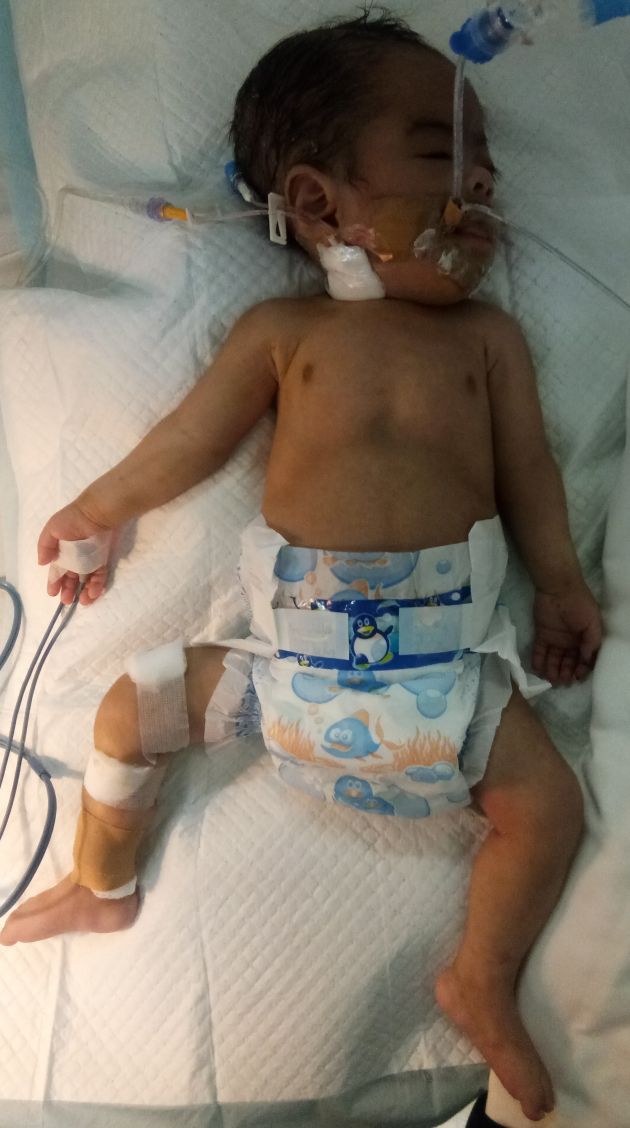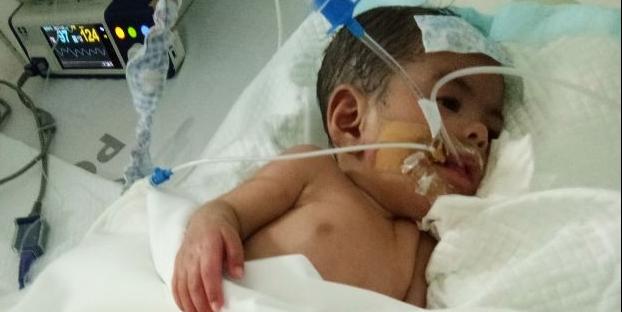Your love helps me keep going…Robi’s Journey
Fundraising campaign by
Iris Lorraine Tiu
-
US$0.00raised of $50,000.00 goal goal
The campaign owner has stopped the page from accepting further donations. Please contact them if you'd still like to donate
Campaign Story
Please take time to read!!!🙏🙏🙏👶
Hi! I am Robi Benison Lordel Tiu Bellin, I am 6 months old, but my corrected age is 4 months old. I am currently confined at the Septic Intensive Care Unit or SICU at the Philippine Children's Medical Center, Quezon City, Philippines. I was born prematurely at exactly 30 weeks (7 months age of gestation) last October 15, 2019, to a hypertensive Mom. I had gone from a traumatic birth injury where my mother suffered a heart failure while giving birth to me. I had been to NICU for 51 days and 3 days basinet. I had been observed for muscle spasms and stiffness and delayed growth.
When I was 2 months old, corrected 0 age, I was confined to the said hospital, I had stridors and in respiratory distress, I also had seizures but had been seizure-free after a week so I went home.
After a month, I was rushed to the same hospital again because I had Apnea for 3 times, untreated stridors, severe retractions, and luckily I was revived...been on oxygen for about a week...again, another episode of Apnea and more than 30 minutes of seizure...again I survived and was intubated then brought to the Pediatric Intensive Care Unit (PICU), I contacted a Hospital Acquired Pneumonia and Sepsis...I had have several Septic Shocks but then again had revived...Now, since my infections were already controlled, I was transferred here at the Septic Intensive Care Unit (SICU)until today.
However, my seizures were uncontrollable and still suffers from shock or desaturation (low oxygen flow of the blood). My doctors had advised me to undergo a procedure called Tracheostomy, a medical procedure — either temporary or permanent — that involves creating an opening in the neck in order to place a tube into a person’s windpipe. The tube is inserted through a cut in the neck below the vocal cords. This allows air to enter the lungs. Breathing is then done through the tube, bypassing the mouth, nose, and throat. A tracheostomy is commonly referred to as a stoma. This is the name for the hole in the neck that the tube passes through.
Another procedure will be done together with the tracheostomy, called Gastrostomy, it is a surgical opening into the stomach. A gastrostomy may be used for feeding, usually via a feeding tube called a gastrostomy tube. Feeding can also be done through a percutaneous endoscopic gastrostomy (PEG) tube.
However, these said procedures were supposedly to be realized last February but until now they were onhold due to Covid hospital lockdown...the procedures will be resumed once the lockdown is lifted.
I had been diagnosed with the following:
1. Quadriphlegic Spastic Cerebral Palsy =
is a specific type of spastic cerebral palsy that refers to difficulty in controlling movements in the arms and the legs. Those who experience this form of Cerebral Palsy will not have paralysis of the muscles, but rather jerking motions that come from stiffness within all four limbs. Just like general CP, children will display symptoms early on in life, and the movements will hinder normal development. The National Institute of Health states that there are generally four causes to spastic quadriplegia: damage to a certain part of the nervous system, general brain damage, bleeding in the brain or a lack of oxygen to the brain. Spastic quadriplegia will normally affect the whole body, even though the name refers to the four limbs on the body. The facial muscles and the core of the body are unable to perform their normal functions due to the intense amount of muscle tightness and strain.
Typically you’ll see symptoms anywhere from three months to two years old. Infants may be unable to control their head or make scissor-like motions with their legs, where their legs come together then cross at the knee. They will be unable to stand or crawl by 12 months, and they’ll have trouble stretching or moving. Their muscles may contract and relax quickly, or there may be general tautness in the muscles that leads to structural damage in the core of the body. It can make it difficult to sit up or control bladder or bowel function.
2. Focal Epilepsy =are characterized by seizures arising from a specific part (lobe) of the brain. Focal epilepsies include idiopathic location-related epilepsies (ILRE), frontal lobe epilepsy, temporal lobe epilepsy, parietal lobe epilepsy and occipital lobe epilepsy. Focal epilepsy may be treated with medication, and occasionally with diet, nerve stimulation or surgery, especially if the condition is due to a scar or other lesion in the brain.
3. Breakthrough Seizures = When an epilepsy patient experiences a sustained period of freedom from seizures (seizure control), then suddenly experiences a seizure, such an event is commonly referred to as a breakthrough seizure. When these breakthrough seizures occur, there can be severe clinical consequences for the patient. For example, patients may need to be examined in a hospital or evaluated in the emergency room. Sometimes fractures or head injuries may occur, which could warrant hospitalization. Cases in which a breakthrough seizure evolves into a ongoing seizure state, or ‘status epilepticus,’ require a well-established series of life-saving interventions, including assessment of airway and vital signs, establishment of intravenous access, blood testing, and loading of antiepileptic medications to try to stop the seizure state. This is very important as status epilepticus is associated with elevated morbidity and, potentially, mortality.
4. Dystonia = Dystonia is a neurological movement disorder syndrome in which sustained or repetitive muscle contractions result in twisting and repetitive movements or abnormal fixed postures. The movements may resemble a tremor. Dystonia is often intensified or exacerbated by physical activity, and symptoms may progress into adjacent muscles.
5. Laryngeal Edema =Laryngeal edema (LE) is a frequent complication of intubation and is caused by trauma to the larynx . The edema results in a decreased size of the laryngeal lumen, which may present as stridor or respiratory distress (or both) following extubation. Ultimately, postextubation laryngeal edema (PLE) may lead to respiratory failure with subsequent need for reintubation.
6. GastroEsophageal Reflux =Gastroesophageal Reflux Disease (GERD) is a digestive disorder that occurs when acidic stomach juices, or food and fluids back up from the stomach into the esophagus. GERD affects people of all ages—from infants to older adults.
7. Hospital acquired pneumonia =Hospital-acquired pneumonia (HAP) or nosocomial pneumonia refers to any pneumonia contracted by a patient in a hospital at least 48–72 hours after being admitted. It is thus distinguished from community-acquired pneumonia. It is usually caused by a bacterial infection, rather than a virus.
8. Sepsis =is a potentially life-threatening condition caused by the body's response to an infection. The body normally releases chemicals into the bloodstream to fight an infection. Sepsis occurs when the body's response to these chemicals is out of balance, triggering changes that can damage multiple organ systems. If sepsis progresses to septic shock, blood pressure drops dramatically. This may lead to death.
9. Hypothyroidism = is a condition in which the thyroid gland is not able to produce enough thyroid hormone. Since the main purpose of thyroid hormone is to "run the body's metabolism," it is understandable that people with this condition will have symptoms associated with a slow metabolism.
10. Umbilical Hernia = An umbilical hernia is an abnormal bulge that can be seen or felt at the umbilicus (belly button). This hernia develops when a portion of the lining of the abdomen, part of the intestine, and / or fluid from the abdomen, comes through the muscle of the abdominal wall.
Low birth weight and premature infants are also more likely to have an umbilical hernia.
11. Undescended Testes = An undescended testicle (cryptorchidism) is a testicle that hasn't moved into its proper position in the bag of skin hanging below the penis (scrotum) before birth. Usually just one testicle is affected, but about 10 percent of the time both testicles are undescended.
An undescended testicle is uncommon in general, but common among baby boys born prematurely.
12. Prematurity =is a term for the broad category of neonates born at less than 37 weeks' gestation. Preterm birth is the leading cause of neonatal mortality and the most common reason for antenatal hospitalization. For premature infants born with a weight below 1000 g, the three primary causes of mortality are respiratory failure, infection, and congenital malformation.
I have been in the hospital for 2 months and 16 days. I am always monitored by my Mom 24/7, my father is just outside the hospital but within the premises because he acts as an errand for my supplies and for my meds if not available in the Pharmacy. From PICU, I was infection free but then, while waiting for the operations to be carried out on me, unfortunately, I had caught some powerful bacterial infections on my lungs, blood and urine that were all hospital- acquired. I have bedsores mostly located at the back of my head. Now, I am still on antibiotic therapy. Due to various medications, I have bwen found to have high levels of Liver Enzymes, it means that my liver is overreacting to the drugs that they had been introducing to my limp body... I only breathe with an aid of a Ventilating Machine because I cannot breath by myself...I am being fed through an Oral Gastro Tube (OGT) with a donated BreastMilk and mixed with formula because my mother cannot breastfed me she is on a maintenance medications. My hospital bill is running at nearly a million. My mother is jobless and my father had been deprived of going to work because of the NCov extreme lockdown. They are my the love of my life. Without them, I would not be here fighting for my life.
How I wish I could do a normal baby grows and reach milestones, how happy would the faces of my parents be...but I was born like this and all my parents could do is love and embrace my imperfections.
I want to live because I want to put smiles on my parents' faces. I also want to feel their love and embraces. I want to feel God's love and His presence. I want to see the beauty of things and the color of life.
To those who have extra resources, I am in need of the following for home medication:
1. Home Ventilating Machine
2. Oxygen Refilling Tanks
3. Suction Machine
4. Nebulizer (I can use if its Covid-free world)
5. Pulse Oxymeter
6. Airbag
7. Gauze Pads
8. Sterile Gloves
9. Cutesept disinfectant
10. Underpads
11. Suction Catheter
12. Tissues
13. Oxygen
14. Oxygen Humidifier
15. Alcohol
With your warm hearts, these would aid me on my long term medications and put hope on my parents who are worried on my current state of being. For the amount you would like to share, please click the DONATE button below.
Hebrews 13:16
"Do not forget to do good and to share with others, for with such sacrifices God is pleased."
Thank you for reaching out...Godbless!
#iamaBabyWarrior
#yourlovekeepsmegetgoing
#thankyouEarthAngels
#GodisaGreatProvider
Organizer
- Iris Lorraine Tiu
- Mother
No updates for this campaign just yet





